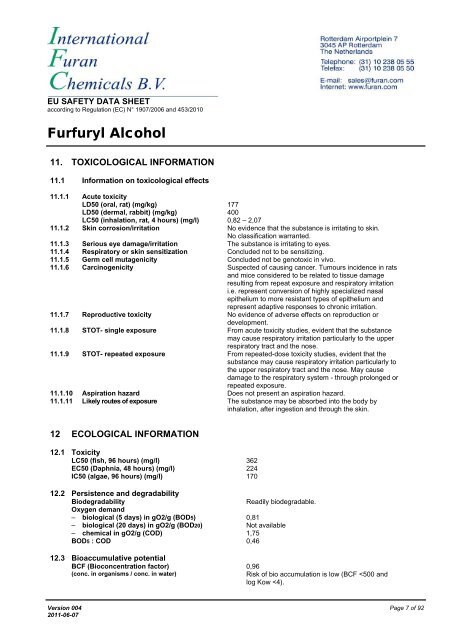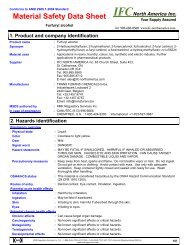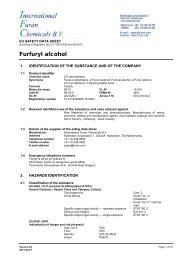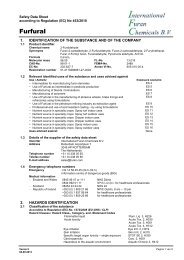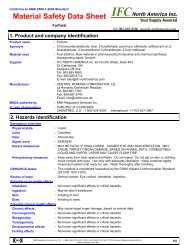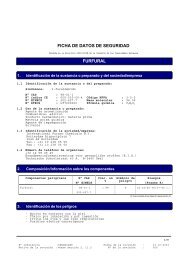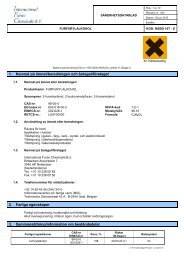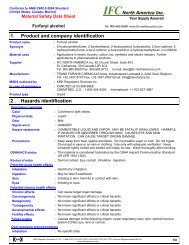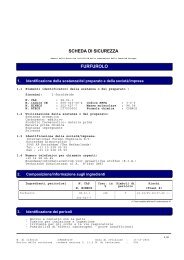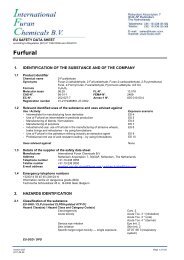Download MSDS of furfuryl alcohol - International Furan Chemicals BV
Download MSDS of furfuryl alcohol - International Furan Chemicals BV
Download MSDS of furfuryl alcohol - International Furan Chemicals BV
You also want an ePaper? Increase the reach of your titles
YUMPU automatically turns print PDFs into web optimized ePapers that Google loves.
EU SAFETY DATA SHEET<br />
according to Regulation (EC) N° 1907/2006 and 453/2010<br />
Furfuryl Alcohol<br />
11. TOXICOLOGICAL INFORMATION<br />
11.1<br />
Information on toxicological effects<br />
11.1.1 Acute toxicity<br />
LD50 (oral, rat) (mg/kg) 177<br />
LD50 (dermal, rabbit) (mg/kg) 400<br />
LC50 (inhalation, rat, 4 hours) (mg/l) 0,82 – 2,07<br />
11.1.2 Skin corrosion/irritation No evidence that the substance is irritating to skin.<br />
No classification warranted.<br />
11.1.3 Serious eye damage/irritation The substance is irritating to eyes.<br />
11.1.4 Respiratory or skin sensitization Concluded not to be sensitizing.<br />
11.1.5 Germ cell mutagenicity Concluded not be genotoxic in vivo.<br />
11.1.6 Carcinogenicity Suspected <strong>of</strong> causing cancer. Tumours incidence in rats<br />
and mice considered to be related to tissue damage<br />
resulting from repeat exposure and respiratory irritation<br />
i.e. represent conversion <strong>of</strong> highly specialized nasal<br />
epithelium to more resistant types <strong>of</strong> epithelium and<br />
represent adaptive responses to chronic irritation.<br />
11.1.7 Reproductive toxicity No evidence <strong>of</strong> adverse effects on reproduction or<br />
development.<br />
11.1.8 STOT- single exposure From acute toxicity studies, evident that the substance<br />
may cause respiratory irritation particularly to the upper<br />
respiratory tract and the nose.<br />
11.1.9 STOT- repeated exposure From repeated-dose toxicity studies, evident that the<br />
substance may cause respiratory irritation particularly to<br />
the upper respiratory tract and the nose. May cause<br />
damage to the respiratory system - through prolonged or<br />
repeated exposure.<br />
11.1.10 Aspiration hazard Does not present an aspiration hazard.<br />
11.1.11 Likely routes <strong>of</strong> exposure The substance may be absorbed into the body by<br />
inhalation, after ingestion and through the skin.<br />
12 ECOLOGICAL INFORMATION<br />
12.1<br />
12.2<br />
12.3<br />
Toxicity<br />
LC50 (fish, 96 hours) (mg/l) 362<br />
EC50 (Daphnia, 48 hours) (mg/l) 224<br />
IC50 (algae, 96 hours) (mg/l) 170<br />
Persistence and degradability<br />
Biodegradability Readily biodegradable.<br />
Oxygen demand<br />
– biological (5 days) in gO2/g (BOD5) 0,81<br />
– biological (20 days) in gO2/g (BOD20) Not available<br />
– chemical in gO2/g (COD) 1,75<br />
BOD5 : COD 0,46<br />
Bioaccumulative potential<br />
BCF (Bioconcentration factor)<br />
(conc. in organisms / conc. in water)<br />
0,96<br />
Risk <strong>of</strong> bio accumulation is low (BCF


